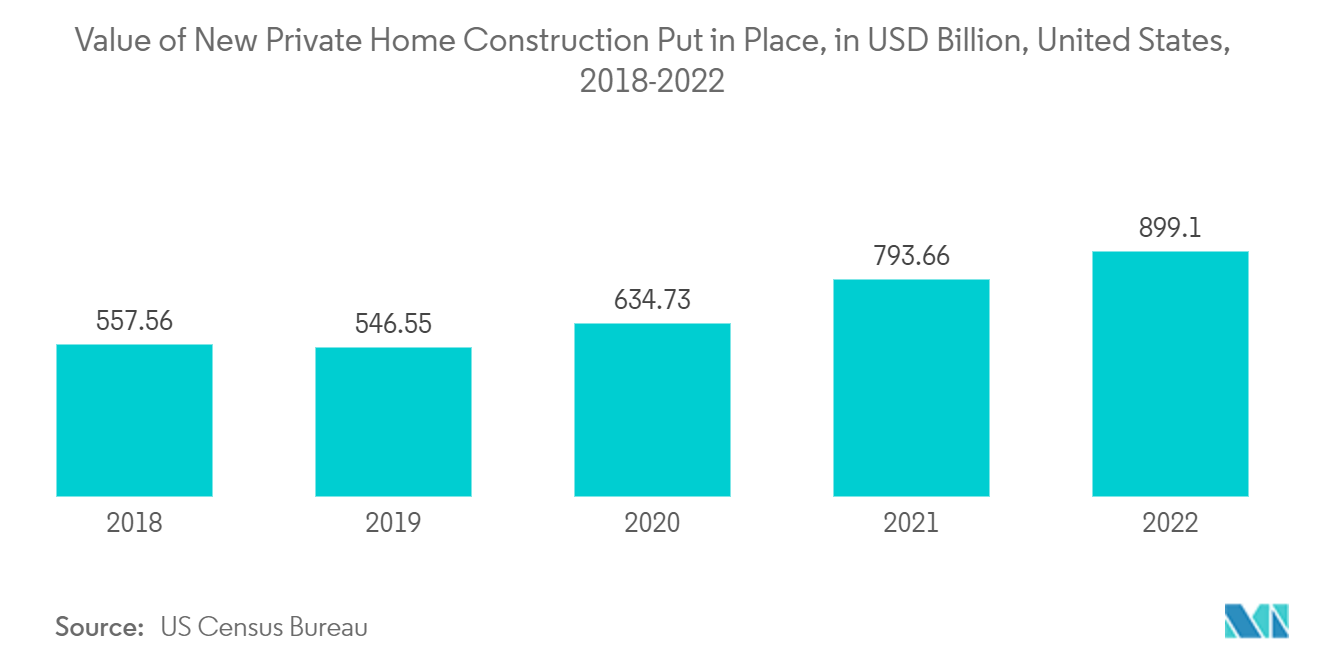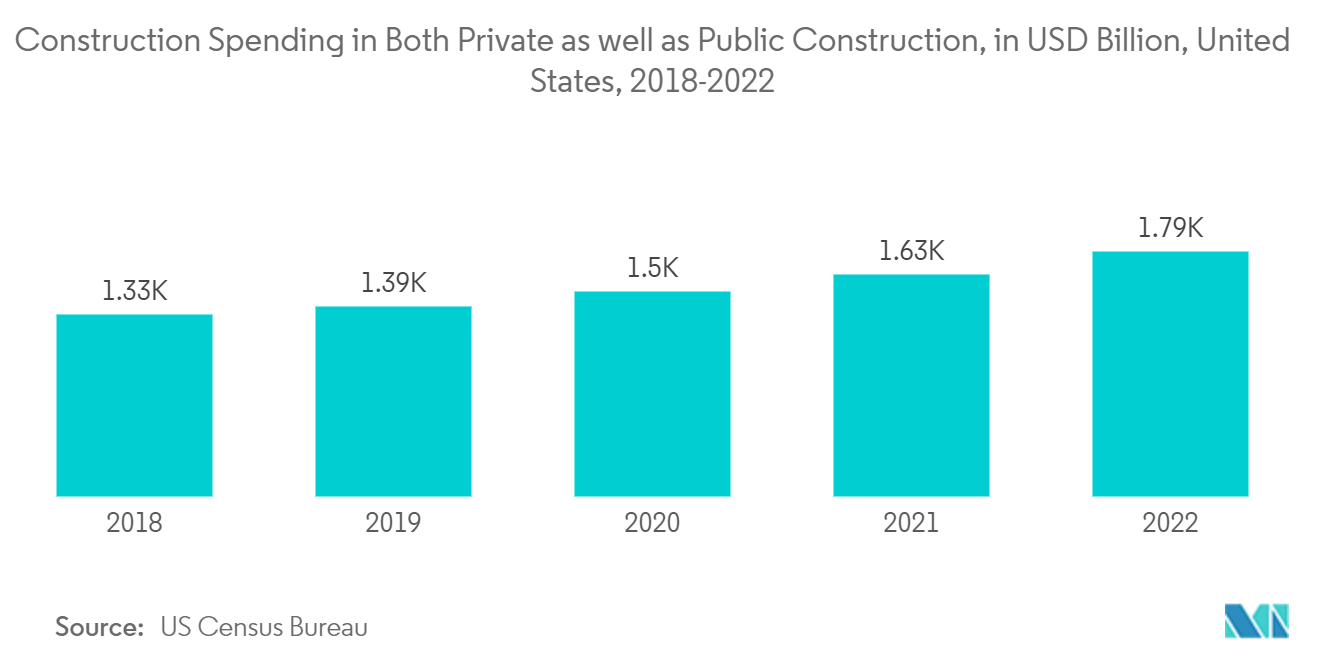Market Trends of North America Ready-Mix Concrete Industry
Residential Segment Showing Great Potential for Growth
- In the North American region, residential development looks promising, with various projects already announced and initiated across major economies like the United States and Canada.
- The applications of ready-mix concrete found in residential construction are curb bedding and backing, reinforced and unreinforced foundations, single and double-story extensions, reinforced and unreinforced house floors, raft, garage, and septic tank bedding, trench fill, garden shed and wall, drainage works, external yard areas, heavy goods vehicle (HGV) parking and driveways, paths, steps, and external paving, and hard standings and bases for greenhouses, patios, and conservatories.
- The increased government spending in the real estate market for residential construction, along with the growing demand for high-class residential homes, are likely to benefit the growth of the market studied. The increased focus on affordable housing by both the public and private sectors is driving the residential construction sector's growth in the region.
- Though the middle-class housing segment is suffering a slump in a few regions of the United States and Canada (as they keep losing ground on affordability), low interest rates for home mortgages have increased residential construction.
- In Canada, various government projects, including the Affordable Housing Initiative (AHI), the New Building Canada Plan (NBCP), and Made in Canada, are set to support the expansion of the sector hugely, thereby driving the use of architectural paints and coatings in the residential sector.
- Furthermore, as per the Harvard Joint Center for Housing Studies, it is estimated that Americans spend more than USD 400 billion a year on residential renovations and repairs, which might as well involve the use of architectural paints and coatings, which positively affects their demand.
- According to the US Census Bureau, the private sector's production of new house building in the United States reached approximately USD 900 billion in 2022, marking the third year of robust growth in a row. This trend is mirrored in the number of dwelling units authorized by building permits, with the Dallas-Fort Worth-Arlington metropolitan area in Texas having some of the largest residential construction production in the country.
- Additionally, in March 2023, 1,413,000 privately owned homes had building permits authorized on a seasonally adjusted annual basis. It was 8.8% lower than the revised February 2023 rate of 1,550,000 and 24.8% lower than the March 2022 rate of 1,879,000. Single-family authorizations were 818,000 in March, up by 4.1% from the revised February figure of 786,000. In March 2023, there were 543,000 authorizations for units in buildings with five or more units.
- Therefore, owing to the aforementioned factors, the demand for ready-mix concrete for the residential industry is likely to impact market growth during the forecast period.

United States to Dominate the Market
- The United States construction sector shows great promise, with residential and infrastructure construction drawing substantial attention and investment.
- The United States boasts a colossal construction sector that employs over 7.6 million people. It plays a prominent role in commercial, industrial, institutional, residential, infrastructure, energy, and utility construction; the construction sector in the country exhibits a significant contribution to the country's economy. As per the Bureau of Economic Analysis, in 2022, the share of the US construction sector in the country's GDP slumped to 4% from 4.1% in the past year.
- According to the US Census Bureau, during February 2023, construction spending in the country was estimated at a seasonally adjusted annual rate of USD 1,844.1 billion, 0.1% lower than the revised January 2023 estimate of USD 1,845.1 billion.
- Moreover, according to the US Census Bureau, in 2022, private construction spending in the United States grew at a rate roughly four times that of public construction spending. When looking at building spending throughout the 50 states, Texas and California came out on top. According to projections, the value of new buildings in the United States will continue to rise in the coming years.
- Similarly, in February 2023, private construction in the country was estimated at a seasonally adjusted annual rate of USD 1.45 trillion, with residential construction assessed at a seasonally adjusted annual rate of USD 852.1 billion, 0.6% lower than the revised January estimate of USD 857.0 billion. Nonresidential construction remained at a seasonally adjusted annual rate of USD 601.0 billion in February 2023, 0.7% higher than the revised January 2023 estimate of USD 596.7 billion.
- In addition to new home construction, the United States is doing massive home renovations. With the growing population of migrants in the country, the need for renovation has become increasingly important. Also, the growing awareness toward sustainability and high-efficiency structures has created a spur in the restoration trend. The availability of several loans by the government also supports home remodeling in the country.
- According to the AIA (American Institute of Architects) Construction Consensus Forecast Panel, non-residential building construction spending expanded to 5.4% in 2022. Further, US expenditure on new private non-residential buildings peaked at over USD 539 billion in 2022. By 2023, all the major commercial, industrial, and institutional categories are projected to witness at least reasonably healthy gains.
- In May 2022, Holcim US acquired a prominent ready-mix concrete company in the Greater Baton Rouge Area, Cajun Ready-Mix Concrete, to further expand its reach in Louisiana through enhanced capacity to serve its customers. The acquisition allowed Holcim to have access to 51 mixer trucks and eight state-certified batch plants that serve Baton Rouge and surrounding cities.
- Further, in May 2022, Martin Marietta Materials Inc. entered into a definitive agreement to divest certain West Coast cement and ready-mixed concrete operations and sell them to CalPortland Company for a transaction of USD 250 million in cash. On completion of the transaction, CalPortland Company will have access to the Redding cement plant, related cement distribution terminals, and 14 ready-mixed concrete plants located in California.
- These factors indicate that residential and infrastructure development may potentially gain strong traction in the coming years, thereby strengthening the market for ready-mix concrete in the region.


